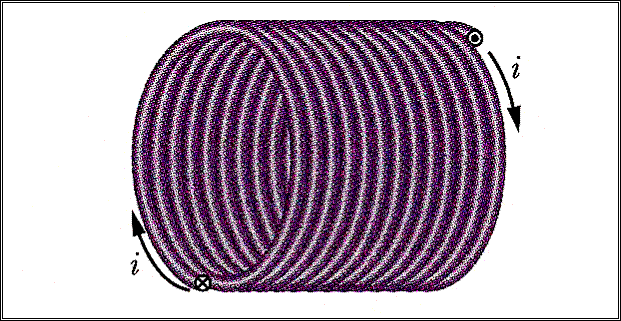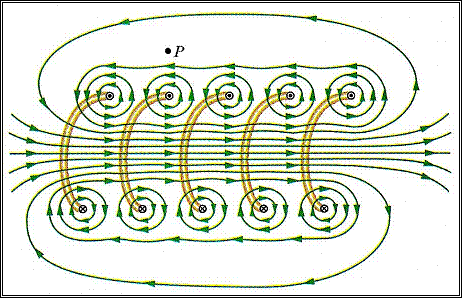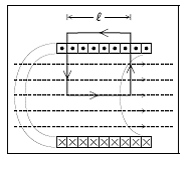Introduction to Magnetic field due to a solenoid
A solenoid is made out of a current-carrying wire that is coiled into a series of turns (with the turns preferably as close together as possible). By wrapping the same wire many times around a cylinder, the magnetic field generated around the wires can become quite strong. The length of a solenoid is much greater than the diameter.
 The external magnetic field due to a solenoid of finite length is quite similar to that of a bar magnet. However, if the solenoid is very long, (i.e., if its length is much greater than its radius), then the field outside will be essentially zero, and inside the solenoid it will be uniform and parallel to the solenoid's axis. The magnetic field inside a solenoid can be easily found using Ampere's law. The number of turns N refers to the number of loops the solenoid has. More loops will bring about a stronger magnetic field. Ampere's law can be applied to find the magnetic field inside a long solenoid as a function of the number of turns per length N/L and the current I. We now look at a cross section of the solenoid.
The external magnetic field due to a solenoid of finite length is quite similar to that of a bar magnet. However, if the solenoid is very long, (i.e., if its length is much greater than its radius), then the field outside will be essentially zero, and inside the solenoid it will be uniform and parallel to the solenoid's axis. The magnetic field inside a solenoid can be easily found using Ampere's law. The number of turns N refers to the number of loops the solenoid has. More loops will bring about a stronger magnetic field. Ampere's law can be applied to find the magnetic field inside a long solenoid as a function of the number of turns per length N/L and the current I. We now look at a cross section of the solenoid.
Solenoid's magnetic field ↓∇ The vector sum of the fields produced by the individual turns (windings) ◄ ↕ to make up the solenoid
 Formula for the magnetic field of a solenoid
Formula for the magnetic field of a solenoid
The figure above shows a section through a portion of a "stretched-out" solenoid
The magnitude of B inside a solenoid can be found by applying Ampere's law to the rectangular integration path shown in the figure above. Outside the solenoid, ~B is zero. Inside, B is at right angles to the ends of the rectangle so the only non-zero contribution to the integral is along the length ` that is inside the solenoid.
Therefore:![]()
The net current through the rectangle is nlI, where n is the number of turns per unit length over the entire length `. Ampere's law then gives for the magnetic field:
B= μ0 n I
The magnetic field inside a solenoid is proportional to both the applied current and the number of turns per unit length. There is no dependence on the diameter of the solenoid or even on the fact that the wires are wrapped around a cylinder and not a rectangular shape.
A typical solenoid behaves like a bar magnet. Magnetic fields produced by solenoids are constant inside the solenoid and parallel to its axis.
Magnetic Field Outside Solenoid
Magnetic field created by a solenoid (cross-sectional view) described using field lines A similar argument can be applied to the loop a to conclude that the field outside the solenoid is radially uniform or constant. This last result, which holds strictly true only near the centre of the solenoid where the field lines are parallel to its length, is important inasmuch as it shows that the flux density outside is practically zero since the radii of the field outside the solenoid will tend to infinity.
A similar argument can be applied to the loop a to conclude that the field outside the solenoid is radially uniform or constant. This last result, which holds strictly true only near the centre of the solenoid where the field lines are parallel to its length, is important inasmuch as it shows that the flux density outside is practically zero since the radii of the field outside the solenoid will tend to infinity.
An intuitive argument can also be used to show that the flux density outside the solenoid is actually zero. Magnetic field lines only exist as loops, they cannot diverge from or converge to a point like electric field lines.
***
Want to know more about magnetic fields due to a solenoid? Click here to schedule a live session with an eAge eTutor!
About eAge Tutoring:
eAgeTutor.com is the premium online tutoring provider. Using materials developed by highly qualified educators and leading content developers, a team of top-notch software experts, and a group of passionate educators, eAgeTutor works to ensure the success and satisfaction of all of its students.
Contact us today to learn more about our guaranteed results and discuss how we can help make the dreams of the student in your life come true!